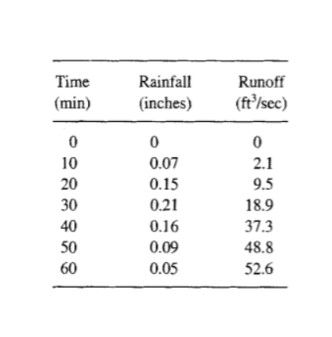
Structural Analysis
6th Edition
ISBN: 9781337630931
Author: KASSIMALI, Aslam.
Publisher: Cengage,
expand_more
expand_more
format_list_bulleted
Question
The following table gives the measured rainfall and surface runoff from a 65-acre
watershed. Values given are averages over the time interval. Compute the
accumulated storage (ft3) of water within the watershed. Plot on the same graph
the inflow, outflow, and cumulative storage as a function of time

Transcribed Image Text:Time
(min)
0
10
20
30
40
50
60
Rainfall
(inches)
0
0.07
0.15
0.21
0.16
0.09
0.05
Runoff
(ft³/sec)
0
2.1
9.5
18.9
37.3
48.8
52.6
Expert Solution
This question has been solved!
Explore an expertly crafted, step-by-step solution for a thorough understanding of key concepts.
This is a popular solution
Trending nowThis is a popular solution!
Step by stepSolved in 2 steps with 1 images

Knowledge Booster
Learn more about
Need a deep-dive on the concept behind this application? Look no further. Learn more about this topic, civil-engineering and related others by exploring similar questions and additional content below.Similar questions
- The following are the ordinates of the 4-hr unit hydrograph for a watershed: Time (hr) 0 2 4 6 Discharge (m/s) 0 20 50 75 i) Derive the 2-hr Unit hydrograph. ii) What is the area of the watershed? 8 90 10 40 12 0arrow_forwardThe 60-year record shows that the annual maximum discharges for a river have a mean of 30,000 cfs, a standard deviation of 28,000 cfs, and a skewness coefficient of 3.15. If the annual maximum discharge can be described by the Extreme-value Type I distribution, what is the probability that the annual maximum discharge exceeds 100,000 cfs at least once in next 10 years? (Note: The sample size is 60. Conduct interpolation using exceedance probabilities or cumulative probabilities.)arrow_forwardProblem 12. (7.76 Chin) During a critical 24-month period the average monthly inflows to a reservoir and the average water demand are given in Table 7.10. Use these data to estimate the minimum required storage volume of the reservoir to overcome that critical period. TABLE 7.10 Average inflow Average demand (m³/s) Average inflow Average demand Average Average inflow (m³/s) demand (m³/s) Month* (m³/s) (m³/s) (m³/s) Month Month 1000 1100 1200 1300 1350 1270 1120 1230 1320 1250 1240 1550 1600 850 1300 17 1400 1400 1400 1130 10 1200 18 11 12 13 19 20 21 1310 1370 1100 1000 1170 1210 1000 1400 1400 940 1000 1300 1260 1400 14 820 1100 22 1200 1400 1400 880 1040 1200 1300 15 23 1100 930 16 1290 24 1080 1000arrow_forward
Recommended textbooks for you

 Structural Analysis (10th Edition)Civil EngineeringISBN:9780134610672Author:Russell C. HibbelerPublisher:PEARSON
Structural Analysis (10th Edition)Civil EngineeringISBN:9780134610672Author:Russell C. HibbelerPublisher:PEARSON Principles of Foundation Engineering (MindTap Cou...Civil EngineeringISBN:9781337705028Author:Braja M. Das, Nagaratnam SivakuganPublisher:Cengage Learning
Principles of Foundation Engineering (MindTap Cou...Civil EngineeringISBN:9781337705028Author:Braja M. Das, Nagaratnam SivakuganPublisher:Cengage Learning Fundamentals of Structural AnalysisCivil EngineeringISBN:9780073398006Author:Kenneth M. Leet Emeritus, Chia-Ming Uang, Joel LanningPublisher:McGraw-Hill Education
Fundamentals of Structural AnalysisCivil EngineeringISBN:9780073398006Author:Kenneth M. Leet Emeritus, Chia-Ming Uang, Joel LanningPublisher:McGraw-Hill Education
 Traffic and Highway EngineeringCivil EngineeringISBN:9781305156241Author:Garber, Nicholas J.Publisher:Cengage Learning
Traffic and Highway EngineeringCivil EngineeringISBN:9781305156241Author:Garber, Nicholas J.Publisher:Cengage Learning


Structural Analysis (10th Edition)
Civil Engineering
ISBN:9780134610672
Author:Russell C. Hibbeler
Publisher:PEARSON

Principles of Foundation Engineering (MindTap Cou...
Civil Engineering
ISBN:9781337705028
Author:Braja M. Das, Nagaratnam Sivakugan
Publisher:Cengage Learning

Fundamentals of Structural Analysis
Civil Engineering
ISBN:9780073398006
Author:Kenneth M. Leet Emeritus, Chia-Ming Uang, Joel Lanning
Publisher:McGraw-Hill Education


Traffic and Highway Engineering
Civil Engineering
ISBN:9781305156241
Author:Garber, Nicholas J.
Publisher:Cengage Learning